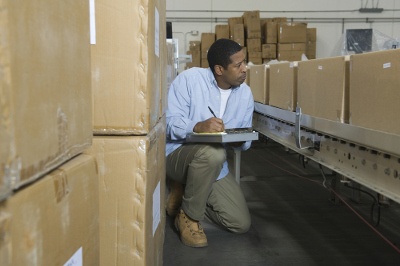 As an importer serious about managing your product quality, the idea of using a single dedicated person to inspect your products might sound both efficient and effective.
As an importer serious about managing your product quality, the idea of using a single dedicated person to inspect your products might sound both efficient and effective.
This inspector would know the ins and outs of your product and be familiar with what you’re looking for and the quality issues you’re worried most about. You could rest well knowing that you have someone you can trust and rely on at your supplier managing your quality control.
But is that really always the case? While there are benefits to using one dedicated inspector, the dangers inherent in sending the same person for all your inspectors may make you reconsider.
With the right background and proper training, there’s no reason why one inspector can’t inspect your products better than another. In fact, insisting on using only one inspector could bring bigger risks to your product quality, the accuracy of your inspection results and your bottom line than you ever imagined.
Let’s delve into some of these commonly overlooked dangers of using one inspector and in what ways relying on multiple inspectors can help you hedge your risk.
1. Heightened integrity risk with repeatedly sending the same product inspector
One of the key qualities of a good inspector is their ability to be totally objective and impartial when reporting what they find.
Anytime you have someone inspecting your products and reporting on their status and condition, there’s the potential for this process and the results to delay shipping. And this works against the interests of any factory owner who just wants to fill and ship as many orders as possible.
But any inspector with integrity must be able to put your interests first. They can’t allow personal relationships with factory staff to sway their judgement and influence their reporting (related: Top 5 Issues That Can Affect QC Auditor Integrity).
 The risk of personal relationships with inspectors, whether fostered intentionally or not, is that a conflict of interests may arise during the course of a service. This can lead the inspector to falsely report inspection results or follow improper inspection protocols, including:
The risk of personal relationships with inspectors, whether fostered intentionally or not, is that a conflict of interests may arise during the course of a service. This can lead the inspector to falsely report inspection results or follow improper inspection protocols, including:
- Falsely reporting the number or type of defects found in the sample: the number of each type of defect found when using AQL sampling will directly affect the pass/fail result you see in the report.
- Falsely reporting on-site testing results: either by skipping the procedure entirely or misreporting the result.
- Overstating order status: falsely guaranteeing completed production processes, rework status or shipping timelines.
- Inspecting a smaller sample size than agreed upon, leading to a smaller and less valuable inspection scope and subsequently less clarity on overall product quality.
- Sharing your confidential information with factories or consumers, perhaps in the form of rejected products, prototypes or design files.
Seeing how much can go wrong if your inspector develops close personal relationship with factory staff, you might be thinking, why not just completely isolate inspectors during the process?
Why inspectors need to collaborate with factory staff
Like it or not, inspectors need to work with factory workers to inspect your products. No matter your product type or inspection scope, all inspectors work in collaboration with staff at the inspection site on some general tasks when checking your goods. These tasks may include:
- Using on-site testing equipment: inspectors often rely on the factory to provide equipment needed for on-site testing. They may also need factory workers to help them set up and actually perform each test.
- Moving selected inspection samples: pulling production samples and moving them for inspection requires cooperation from staff in the factory or warehouse.
- Unpacking/repacking: in case of a pre-shipment inspection, factory workers often assist with unpacking the goods from shipping and retail cartons before inspection and repacking them after inspection.
 Inspectors also might need to ask factory staff questions regarding their operations or production processes to gather all the information needed for reporting. And factory managers often prefer to have a factory representative present to oversee the inspection and on-site testing procedures.
Inspectors also might need to ask factory staff questions regarding their operations or production processes to gather all the information needed for reporting. And factory managers often prefer to have a factory representative present to oversee the inspection and on-site testing procedures.
This working relationship between the inspector and factory is a natural, and necessary, part of third-party inspection. But if inspectors spend a lot of time on-site at a factory, the danger is that inspectors and factory staff can develop a close, personal relationship over time. Your chance of this and related integrity problems occurring increases over time when you have one inspector repeatedly working closely with the same factory staff.
How rotating inspectors limits your integrity risk
By regularly rotating inspectors, you significantly lower your chances of relationships forming that hinder inspector objectivity, particularly when placing multiple orders with the same factory over time. And by limiting the amount of time any one inspector spends at one factory, you can be more confident that inspector will remain impartial throughout inspection and reporting.
Many professional third-party QC companies have a large enough network of inspectors to effectively rotate them without increasing travel time, expenses or your inspection costs (related: How InTouch Prevents Corruption Issues from Hijacking Your Product QC). Failing to take advantage of this network and policy of rotating inspectors might put both your inspection results and product quality in jeopardy.
2. Higher inspection costs when working with a third-party product inspection provider
Have you ever considered the amount of time the average product inspector spends traveling to and from an inspection site?
 Professional inspectors need to visit a facility almost every day, sometimes an hour or more away from their home, to perform inspection. And the amount of work an inspector can do in a day is limited by how long they can be at the inspection site. This is why many product inspection providers bill by what are called “man days”, a standardized unit of an inspector’s time.
Professional inspectors need to visit a facility almost every day, sometimes an hour or more away from their home, to perform inspection. And the amount of work an inspector can do in a day is limited by how long they can be at the inspection site. This is why many product inspection providers bill by what are called “man days”, a standardized unit of an inspector’s time.
Let’s say you need an inspection at your supplier’s facility tomorrow. Because of the distance from their home to the factory, your preferred inspector can’t be there until 11:00 AM. And factory managers often aren’t willing to keep the factory open longer to accommodate inspection. That means the time available for inspection could be two hours shorter than if you’d sent an inspector that could arrive at the factory by 9:00 AM.
What’s worse is the inspector might rush to complete the inspection, potentially overlooking serious defects or making errors in compiling the report. Now you have to worry about whether the inspector actually had time to check the full sample size and what costs you may pay if your products have problems that weren’t included in their report.
How leveraging multiple inspectors can lower your inspection costs
Now imagine another inspector can reasonably arrive on site by 9:00 AM. They would have two full hours more to perform the same inspection and at no added cost to you. In fact, your costs could actually be lower because your product inspection provider is including less travel time when billing (related: How InTouch Balances Your QC Inspection Needs With Your Budget).
Third-party inspection providers typically have multiple inspectors based in each major manufacturing region. Some might be located closer to and others farther from your supplier’s facility. They can choose among a few qualified inspectors to send the one that’s based closest to the factory.
The bottom line: your inspector spends more time checking your product and less time traveling to and from the inspection site.
3. Production and shipping delays due to limited availability of one inspector
Whether you’re hiring an independent contractor or a third-party inspection firm, insisting on any one particular inspector for your goods often causes delays.
Let’s say you have a shipment expected to leave the factory in three days. You want a pre-shipment inspection to confirm the goods are ready and free of major issues. But when you contact your preferred inspector about the service, they tell you they’re unavailable for the next two days. You’re suddenly faced with a dilemma. Your choices are:
- Risk customer complaints due to late shipments by holding the shipment until your preferred inspector is free to check the goods; or
- Risk customer complaints due to product quality problems by forgoing inspection altogether in order to ship the goods on time
 Not much of a choice, is it?
Not much of a choice, is it?
And the situation becomes more complicated if your preferred inspector is available a certain day that’s not convenient for the factory. Third-party inspection companies and independent contractors typically can’t force a supplier to allow inspectors to visit on a given day (related: Why Product Inspection Companies Can’t Compel Your Chinese Suppliers).
Instead, they must conduct inspections based on your supplier’s availability. If you delay an inspection based on one inspector’s availability, it may be a few days before the factory and the inspector can accommodate the inspection. This can delay production in the case of an early or during-production inspection or delay shipping in the case of pre-shipment inspection.
How using multiple inspectors prevents delays
Being open to sending one of several qualified inspectors to check your products frees you from potential scheduling problems that can cause delays.
Third-party inspection companies balance a number of different inspections a day in certain regions and generally schedule inspectors a few days in advance. By having multiple inspectors available in a given service area and booking in advance, there’s a much lower chance that you’ll face delays.
When lead times are tight you won’t have to choose between shipping on time or inspecting your goods. You and your customers will get to “have your cake and eat it too”!
4. Lower efficiency with one product inspector
One product inspector often needs to be on-site for several days in a row to complete inspection when there’s a larger scope or order size. The sample size they inspect typically numbers in the tens or hundreds of units when using AQL for inspection. The quantity to inspect could be much higher if you need 100 percent inspection of the full order size.
Less efficiency with one inspector checking larger sample sizes doesn’t just take more time. Two problems can occur when you have one inspector returning repeatedly to the same factory to inspect a large order:
- There’s greater risk of integrity issues resulting from the same inspector spending more time with staff at the same factory (see #1 above); and
- More time needed for one person to inspect more units means there’s a higher chance of production or shipping delays
Keep in mind that any rework or other corrective action needed after inspection will take even more time. And cutting down on the time required for inspection can help you more quickly review inspection results, request any necessary corrections and approve shipments.
How sending multiple inspectors helps maintain efficiency
It’s not unusual for inspection companies to quote six or more man days for inspections with larger quantities. But with several inspectors available, it’s often possible to send multiple inspectors on the same day to one facility to speed up the overall inspection process.
The same six-man-day inspection that might have taken one person six business days to complete can take just three business days for two people or two business days for three people.
Multiple inspectors also offer you greater room to adapt to changes in scale as your manufacturing volume or quality inspection criteria change. For example, maybe you’ve previously been inspecting 80 units and then suddenly need to start inspecting 315 units. Having multiple inspectors available means you won’t have to account for major changes in lead time with shipping and inspection.
5. Inadequate expertise for inspecting diverse product lines
One of your main requirements when choosing who to send to inspect your product could be that they have expertise relevant to your product. In the same way you probably wouldn’t consult a neurologist about a skin condition, you probably wouldn’t send a textile expert to inspect industrial furnaces.
Types of quality defects, on-site testing procedures and inspection protocols vary for each product type. And if you manufacture a diverse range of different products, one dedicated inspector may not have the necessary experience and knowledge to inspect all your products.
Inspectors are often specialized and experienced in inspecting one of the following categories:

- Softline products, including garments, textiles, footwear and other fabric-based products
- Hardline products, including kitchenware, toys, furniture, appliances and more
- Industrial products, including industrial components and machinery
- Electrical and electronic products, including assembled consumer electronics and electronic components
Depending on your industry or product niche, your products may fall into multiple categories. For instance, a sporting goods brand might manufacture bicycles, electronic fitness trackers and cycling apparel.
Even products within the same product category may require different expertise. For example, for a kitchenware importer, stainless steel items and silicone accessory items vary drastically in their materials and production methods. A single dedicated inspector would need to have expertise in both product types to provide a valuable assessment of product quality.
Why more inspectors offer more diverse product knowledge
It’s often more feasible and effective for importers of diverse product lines to use multiple inspectors for different product types.
Specialized knowledge in one product type is often more valuable than a general, surface-level knowledge of a number of different products. And specialized inspectors will be more familiar with common quality issues, some common causes and solutions to those quality issues and important applicable legal regulations for that product type.
Though they might employ tens of inspectors in one region, many third-party inspection companies usually hire and train inspectors with focused experience in a limited number of product types.
Conclusion
It may seem that having a dedicated inspector for your products is a good idea on the surface. But the dangers of using one dedicated inspector are often revealed as you dig deeper. Many importers suffer delays and other stressful events with manufacturing because of a limiting belief that the same person should inspect their products every time.
Professional third-party inspection providers should have internal policies and controls in place to ensure that each inspector is aware of your inspection requirements, product specifications and product quality history. This ensures that even if they’ve never inspected your product before, inspectors are trained and prepared to accurately verify and report on its quality.
Having a detailed QC checklist available for reference during inspections further helps eliminate your need to depend on any one inspector (related: 5 Essentials of a QC Checklist [eBook]). Above all, a thorough QC checklist with your product specifications and inspection requirements is the best way to ensure consistency in inspection and reporting from one inspector to the next.
How do you ensure consistency in reporting when using multiple inspectors? Share your comments in the comment section below!







